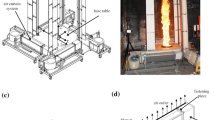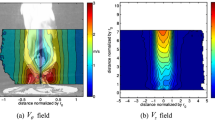Abstract
Numerical studies on internal fire whirls (IFW) generated in a vertical shaft model with a single corner gap were reported in this paper. The generation of IFW, burning rate of fuel and temperature were studied experimentally first. Numerical simulations on medium-scale IFW were carried out using a fully-coupled large eddy simulation incorporating subgrid scale turbulence and a fire source with heat release rates compiled from experimental results. Typical transient flame shape was studied and then simulated numerically by using temperature. The dynamic phenomena of generation and development of IFW were simulated and then compared with experimental results. The predicted results were validated by comparing with experimental data, which demonstrated that an IFW can be simulated by Computational Fluid Dynamics. Numerical results for flame surface, temperature, and flame length agreed well with the experimental results. The IFW flame region and intermittent region were longer than those for an ordinary pool fire. The modified empirical formula for centerline temperature was derived. Variations of vertical and tangential velocity in axial and radial directions were also shown. The vortex core radius was found to be determined by the fuel bed size. Velocity field was not measured extensively due to resources limitation. Comparing measured temperature distribution with predictions is acceptable because temperature is related to the heat release rate, air flow and pressure gradient.
Similar content being viewed by others
Abbreviations
- C :
-
combustion heat
- C S :
-
turbulence subgrid scale (SGS) Smagorinsky model coefficient
- c p :
-
specific heat of air
- D*:
-
flame characteristic diameter
- D T :
-
mass diffusion coefficient
- g :
-
acceleration due to gravity
- k :
-
coefficients for centerline correlations
- k T :
-
heat-conductivity coefficient
- l :
-
grid size
- m :
-
mass
- Pr T :
-
turbulent Prandtl number
- Q :
-
heat release rate (HRR)
- Qexp :
-
stable stage HRR
- \({\overline Q _{\exp}}\) :
-
mean HRR of six stages
- Q num :
-
input stable stage HRR
- \({\overline Q _{{\rm{num}}}}\) :
-
input mean HRR
- R :
-
burning rate
- r :
-
radial distance from centerline
- Sc T :
-
turbulent Schmidt number
- S jj :
-
deformation rate tensor. i for normal direction and j for projective direction
- T :
-
temperature
- ΔT :
-
excess temperature
- T 0 :
-
ambient air temperature
- t :
-
time
- U j :
-
velocity components (u, v, w) along the x, y, z Cartesian coordinate
- Δx, Δy, Δz :
-
grid dimensions along the x, y, z directions
- Y i :
-
mass fraction of component i
- z :
-
height from fuel surface
- Δ :
-
subgrid length scale
- δ :
-
rate of particle nucleation for soot volume fraction
- η :
-
exponent of centerline correlation
- μ T :
-
turbulent viscosity coefficient
- ρ :
-
density
- ρ0 :
-
ambient air density
- σ :
-
combustion ratio
- τ SGS :
-
viscous stress tensor
- Ω:
-
tangential velocity
References
Bullen ML, Thomas PH (1979). Compartment fires with non-cellulosic fuels. Symposium (International) on Combustion, 17: 1139–1148.
Cai N, Chow WK (2014). Numerical studies on heat release rate in a room fire burning wood and liquid fuel. Building Simulation, 7: 511–524.
Cheung SCP, Yeoh GH (2009). A fully-coupled simulation of vortical structures in a large-scale buoyant pool fire. International Journal of Thermal Sciences, 48: 2187–2202.
Chow WK (1995). Use of computational fluid dynamics for simulating enclosure fires. Journal of Fire Sciences, 13: 300–334.
Chow WK, Han SS (2009). Experimental investigation on onsetting internal fire whirls in a vertical shaft. Journal of Fire Sciences, 27: 529–543.
Chow WK (2013). Air pumping action of a plume in a room fire. Building Simulation, 6: 95–102.
Chow WK, Dang JF, Gao Y, et al. (2017). Dependence of flame height of internal fire whirl in a vertical shaft on fuel burning rate in pool fire. Applied Thermal Engineering, 121: 712–720.
Chuah KH, Kuwana K, Saito K (2009). Modeling a fire whirl generated over a 5-cm-diameter methanol pool fire. Combustion and Flame, 156: 1828–1833.
Dahanayake KC, Yang Y, Wan Y, et al. (2020). Study on the fire growth in underground green corridors. Building Simulation, 13: 627–635.
Emmons HW, Ying SJ (1996). The fire whirl. In: Proceedings of the 11th international Symposium on Combustion, Berkeley, CA, USA.
Gao Z, Li S, Gao Y, et al. (2019). Experimental studies on characteristics of fire whirl in a vertical shaft. Fire and Materials, 43: 229–240.
Gong J, Li Y (2010). CFD modelling of the effect of fire source geometry and location on smoke flow multiplicity. Building Simulation, 3: 205–214.
Harish R, Venkatasubbaiah K (2015). Large eddy simulation of thermal plume behavior in horizontally partitioned dual enclosure. Building Simulation, 8: 137–148.
Jain S, Shashi, Kumar S (2011). Numerical studies on evaluation of smoke control system of underground metro rail transport system in India having jet injection system: A case study. Building Simulation, 4: 205–216.
Jiang Y, Chen Q (2001). Study of natural ventilation in buildings by large eddy simulation. Journal of Wind Engineering and Industrial Aerodynamics, 89: 1155–1178.
Lei J, Liu N, Lozano JS, et al. (2013). Experimental research on flame revolution and precession of fire whirls. Proceedings of the Combustion Institute, 34: 2607–2615.
Lei J, Liu N, Zhang L, et al. (2015). Temperature, velocity and air entrainment of fire whirl plume: A comprehensive experimental investigation. Combustion and Flame, 162: 745–758.
Lei J, Liu N, Tu R (2017). Flame height of turbulent fire whirls: A model study by concept of turbulence suppression. Proceedings of the Combustion Institute, 36: 3131–3138.
Li S, Yao Q, Law CK (2019). The bottom boundary-layer structure of fire whirls. Proceedings of the Combustion Institute, 37: 4277–4284.
Liu SL, Chow WK (2002). A review on numerical simulation of turbulent flow. International Journal on Architectural Science, 3(2): 77–102.
Ma TG, Quintiere JG (2003). Numerical simulation of axi-symmetric fire plumes: Accuracy and limitations. Fire Safety Journal, 38: 467–492.
McCaffrey BJ (1979). Purely buoyant diffusion flames: Some experimental results, NBSIR 79–1910. Gaithersburg, MD, USA: National Bureau of Standards.
McGrattan KB (2004). Fire Dynamics Simulator (Version 4)—Technical Reference Guide, NIST Special Publication 1018. Gaithersburg, MD, USA: National Institute of Standards and Technology.
McGrattan KB, Forney GP (2004). Fire Dynamics Simulator (Version 4)—User Guide. NIST Special Publication 1019. Gaithersburg, MD, USA: National Institute of Standards and Technology.
Murakami S (1998). Overview of turbulence models applied in CWE-1997. Journal of Wind Engineering and Industrial Aerodynamics, 74–76: 1–24.
Sahu D, Kumar S, Jain S, et al. (2017). Full scale experimental and numerical studies on effect of ventilation in an enclosure diesel pool fire. Building Simulation, 10: 351–364.
Satoh K, Yang KT (1996). Experimental observations of swirling fires. In: Proceedings of ASME Heat Transfer Division, HTD-Vol. 335, pp. 393–400.
Satoh K, Yang KT (1997). Simulation of swirling fires controlled by channeled self-generated entrainment flows. In: Proceedings the 5th International Symposium, International Association for Fire Safety Science, pp. 208–216.
Satoh K, Yang KT (1998). Experiments and numerical simulations of swirling fires due to 2×2 flames in a channel with single corner gap. In: Proceedings of ASME International Mechanical Engineering Congress and Exposition, ASME Heat Transfer Division, Anaheim, CA, USA.
Satoh K, Yang KT (1999). Measurements of fire whirl from a single flame in a vertical square channel with symmetrical corner gaps. In: Proceedings of ASME International Mechanical Engineering Congress and Exposition, ASME Heat Transfer Division, Nashville, TN, USA.
Snegirev AY, Marsden JA, Francis J, et al. (2004). Numerical studies and experimental observations of whirling flames. International Journal of Heat and Mass Transfer, 47: 2523–2539.
Soma S, Saito K (1991). Reconstruction of fire whirls using scale models. Combustion and Flame, 86: 269–284.
Tohidi A, Gollner MJ, Xiao H (2018). Fire whirls. Annual Review of Fluid Mechanics, 50: 187–213.
Wang H (2009). Numerical study of under-ventilated fire in medium-scale enclosure. Building and Environment, 44: 1215–1227.
Williams FA (2017). Scaling fire whirls. Keynote lecture, In: Proceedings of the 8th International Symposium on Scale Modelling (ISSM-8), Portland, OR, USA.
Yu H, Guo S, Peng M, et al. (2013). Study on the influence of air-inlet width on fire whirls combustion characteristic. Procedia Engineering, 62: 813–820.
Yuen ACY, Yeoh GH, Alexander B, et al. (2014). Fire scene investigation of an arson fire incident using computational fluid dynamics based fire simulation. Building Simulation, 7: 477–487.
Zhang W, Chen Q (2000). Large eddy simulation of indoor airflow with a filtered dynamic subgrid scale model. International Journal of Heat and Mass Transfer, 43: 3219–3231.
Zhang W, Hamer A, Klassen M, et al. (2002). Turbulence statistics in a fire room model by large eddy simulation. Fire Safety Journal, 37: 721–752.
Zhou X, Luo KH, Williams JJR (2001). Numerical studies on vortex structures in the near-field of oscillating diffusion flames. Heat and Mass Transfer, 37: 101–110.
Zou GW, Chow WK (2015). Generation of an internal fire whirl in an open roof vertical shaft model with a single corner gap. Journal of Fire Sciences, 33: 183–201.
Zukoski EE, Kubota T, Cetegen B (1981). Entrainment in fire plumes. Fire Safety Journal, 3: 107–121.
Acknowledgements
This study was sponsored by the National Natural Science Foundation of China (No. 11402061). The work described in this paper was also partially supported by a grant from the Research Grants Council of the Hong Kong Special Administrative Region, China, for the project “A study on electric and magnetic effects associated with an internal fire whirl in a vertical shaft” (Project No. PolyU 15206215) with account number B-Q47D.
Author information
Authors and Affiliations
Corresponding author
Electronic Supplementary Material
Rights and permissions
About this article
Cite this article
Gao, Z., Li, S.S., Gao, Y. et al. Numerical studies on swirling of internal fire whirls with experimental justifications. Build. Simul. 14, 1499–1509 (2021). https://doi.org/10.1007/s12273-020-0756-5
Received:
Revised:
Accepted:
Published:
Issue Date:
DOI: https://doi.org/10.1007/s12273-020-0756-5




